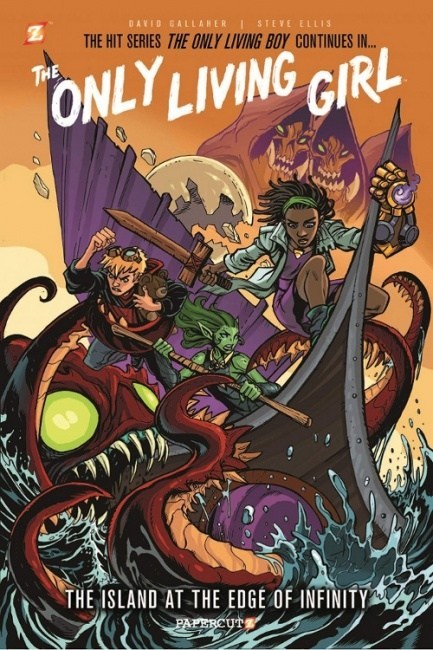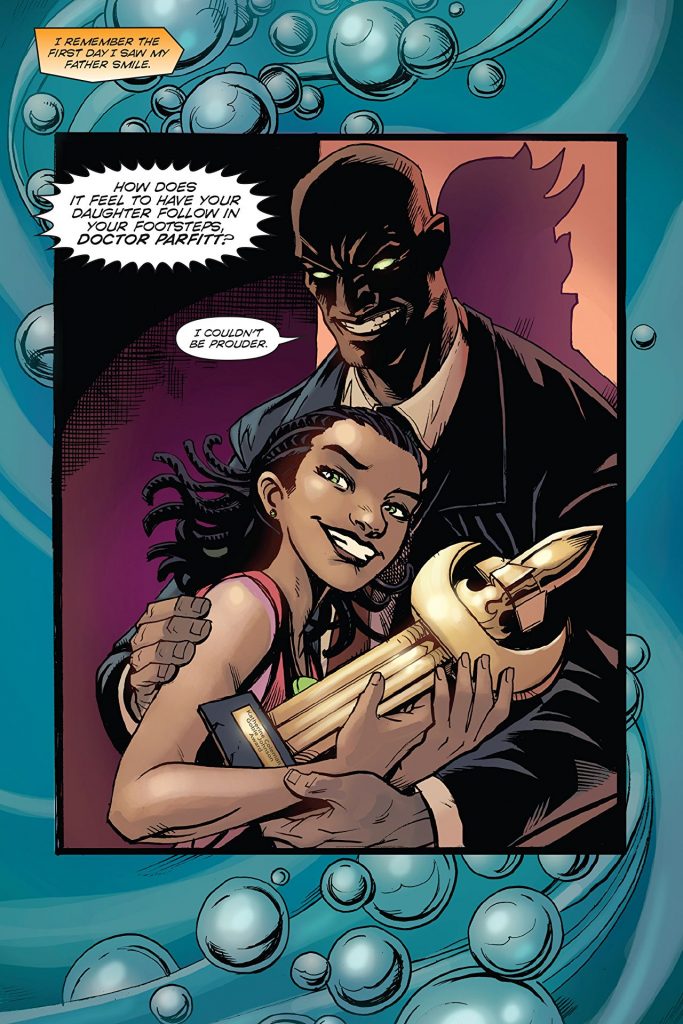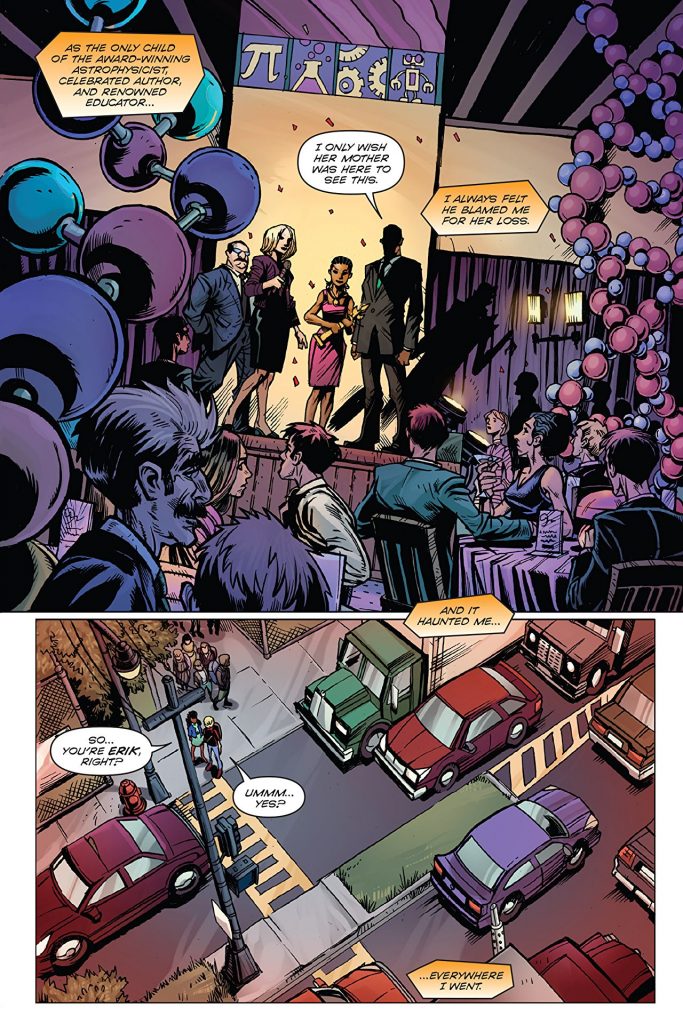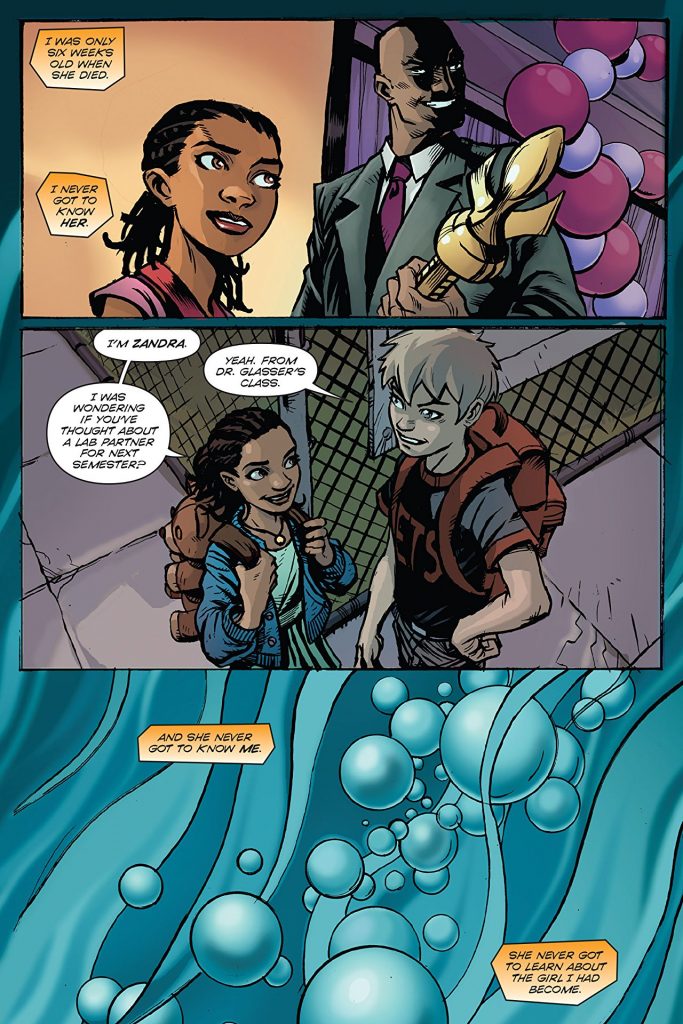
- The Only Living Girl #1
- Papercutz
- Created by David Gallaher & Steve Ellis
- Written by David Gallaher
- Illustrated by Steve Ellis
- Additional Colors by Chris Sotomayor
- Letters by Nate Pride
Zandra ‘Zee’ Parfitt is one of the last human survivors of a cosmic disaster that merged hundreds of planets into the mysterious patchwork wasteland of Chimerika. After learning that the experiments of her late father, the diabolical Doctor Once, created this world, Zee and her companions — classmate Erik Farrell and mermaid warrior Morgan — embark on a dangerous quest filled with robots, monsters, unknown civilizations, and unlikely allies. Together they push back against the relentless Consortium, who want control of this new world at any cost. Through it all, Zee searches for the truth of her past so she can redeem her father’s legacy.
From the award-winning team behind THE ONLY LIVING BOY, David Gallaher and Steve Ellis bring you THE ONLY LIVING GIRL, an action-packed adventure perfect for fans of AMULET, MS. MARVEL, and DC SUPER HERO GIRLS.
After an accident left her near-death, Zee’s father made a deal to preserve her life. While not unusual in itself, in the case of renowned scientist Dr. Thomas Parfitt it led to some pretty resounding events. Making his pact with the power mad group of scientists calling themselves the Consortium, Dr. Parfitt allowed himself to be transformed into the infamous Dr. Once. Working toward the Consortium’s goals, he created the patchwork planet called Chimerika out of material culled from countless other worlds. Among the inhabitants of this new world, Dr. Once was a name spoken with stomach churning dread. Now, Zee is left trying to find her own way, independent of the terrible legacy her father left behind.
The term “world building” is generally used to refer to a writer’s creation of a setting for whatever story they’re trying to craft, in whatever medium they’re trying to craft it. In the case of David Gallaher and Steve Ellis, it wasn’t enough just to say, “hey, let’s make something that kinda looks like the planet Mongo but different.” In their previous outing, The Only Living Boy, they established the literal “patchwork planet” of Chimerika and populated it with as bizarre and mismatched a group of citizens as you’re likely to find. Consisting of- among others- the insectoid Sectaurians, the amphibious Mermidonians, and the subterranean Alku, the artificial planet was ruled by the evil overlord (has there ever been a benevolent overlord?) Baalikar. The regime came to an end when the “only living boy” Erik Farrell arrived to foul up the works.
Where The Only Living Boy dealt with issues of courage, coping, & acceptance, Zee’s story takes a very different spin. Waking up in the world her father literally created, she’s left with the burden of overcoming the misconceptions of those around her. Zee never knew “Dr. Once”… she only knew Thomas Parfitt, her father, the dedicated scientist. While he may have been less than outgoing when it came to his love for his daughter, after the accident that nearly killed her he gave up everything in order to save her. On being awakened by Erik, Zee has to find her own path through the strange new world she lives in.
I was a big fan of Gallaher and Ellis’s work in The Only Living Boy (and again in High Moon, a very different collaboration for the creative team). When David Gallaher asked if I’d be interested in seeing a preview for the next chapter in their Chimerikan Saga, I was pretty stoked. Now that I’ve had the chance to read the full opening installment, I can say that my excitement was justified.
Gallaher’s scripted a pretty deep look into the aftermath of a successful revolution. Where a reader is usually left with the joyous celebration of a liberated populace, he digs down to the consequences of a sudden power vacuum. Sure, Lord Baalikar is gone (Huzzah!), but what about all of the other dilemmas created by his regime? The citizens of Chimerika were pulled from their worlds against their will, forced to adapt to life on a new planet. Many of them just want to go home. Then again, some would rather stay on Chimerika, for better or worse. That calls for some new form of leadership… preferably one that doesn’t involve the interference of the unaccounted for scientists of the Consortium. On a more personal level, there are people like Zee who have to overcome bias from without, and her own inner doubts as she tries to figure out how she can fit into her strange new life. Gallaher handles it all without resorting to heavy-handed exposition. Much of it is told through Zee’s own inner monologue, displaying her uncertainties while expressing her desire to do better than her father… a man she really didn’t know. The rest is given through observation as the reader is taken on a quick tour of the patchwork planet, in a great example of a “show, don’t tell” narrative.
No comicbook is worthy of the name without pictures- literally, it’d just be a book- so we’re probably gonna have to talk about the work of Steve Ellis. As a co-creator on the series, Ellis is in a great spot artistically. Rather than being stuck with matching his work to Gallaher’s descriptions, he’s able to inject his own imaginings into the mix early on. The result has been some very impressive design work in both the characters and their environment. In the opening sequence of the book, Ellis moves the reader back and forth from Zee’s home city on Earth, to the sinister laboratory of Dr. Once, in a series of flashbacks. After that, it’s on to the heart of Chimerika itself, a world trying to figure itself out from the sum of its parts. Ellis makes sure that no one part of Chimerika looks like any other, keeping to the patchwork theme in a way that I can only imagine required some aspirin and a lot of coffee at some point. Likewise, Ellis’s designs on the various creatures and characters runs through all the shades from bizarre to mundane and back again. Even members of the same species are given enough distinction to make it difficult to mistake one for anyone else.
I’ll be the first to admit that I lost patience with Erik’s story arc in The Only Living Boy. He was kinda whiney, and a bit of a cling-on through much of the book. Yeah, I know… he was a kid and they do tend to whine a lot (sorry, kids, but it’s true) so I’m more than willing to admit that it was my issue more than anything. Still, Zee’s story is starting out very differently from Erik’s, and I’m finding myself willing to give her a little more room to grow before I start harping on her to grow up.
See that? Character growth… and I’m just a reviewer!
The Only Living Girl is a family friendly adventure that lets kids be kids while exploring the depth of family ties and themes of legacy. There’s some violence in the action… parents, please make sure you get your kids’ permission before reading alone.
Final Grade: an easy A!


